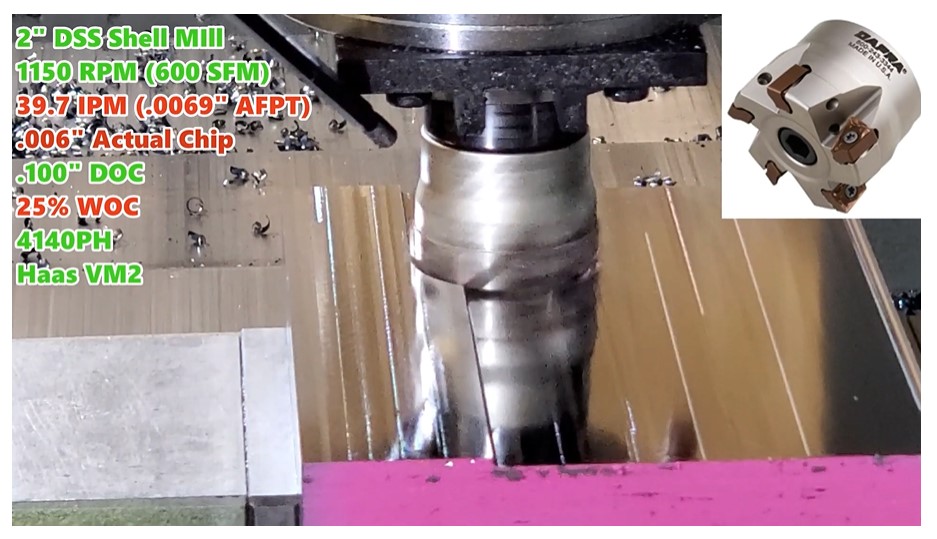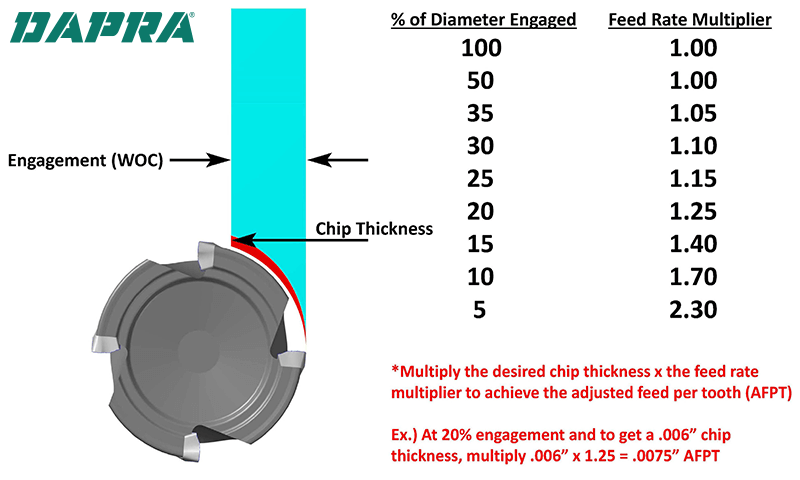Radial engagement feed rate adjustment calculations to maximize your productivity
If you’re milling at less than 50% of your cutting tool diameter without leveraging radial chip thinning, you’re leaving money on the table. Minimize your cycle time – and maximize productivity – by properly adjusting your programmed feed per tooth. At a 5% WOC, you could unlock a 130% productivity increase!
This detailed video explains how radial (side) chip thinning works, and how to adjust feed rates for your milling tool based on the percent of radial engagement (width of cut) of your milling tool. This instruction is applicable for all indexable and solid milling tools.
Only interested in live cutting tool footage illustrating this principle? Scroll down for a shorter video, or to download a handy printable reference chart of radial engagement feed rate adjustment multipliers.
What is Radial Chip Thinning?
The initial chip thickness as your insert enters the cut is very thin. As the insert progresses through the material, the chip gets thicker, up to the center line of the cutting tool. Once the insert progresses past that point, the chip gets thinner again, down to a feather-edge where the insert exits the material.
So, at 100% WOC, the actual chip thickness is equal to your programmed feed per tooth (FPT). At 50% WOC, we are still removing material right up to the center point, so the actual chip thickness is still at its maximum – equal to the programmed FPT.
Live Cutting Tool Footage:
At 35% WOC, we start to see things change a bit. The material doesn't reach the cutter's center line, and actual chip thickness drops to 95% of the programmed FPT. If you continue to run at the original programmed chip thickness, you will essentially be under-feeding your milling tool. To get back to that true desired chip thickness, we need to multiply that number by 1.05 to come up with an adjusted FPT (AFPT) for our program – giving us a 5% productivity increase.
As your percent WOC decreases, operating at a proper AFPT for our desired chip thickness unlocks far more dramatic productivity increases. At 10% WOC, a 1.70 multiple feed rate adjustment brings you a 70% productivity increase. At 5% WOC, you can increase productivity by 130% versus the original programmed FPT.
Using these adjusted numbers will make a big difference in your productivity, cycle times and tool life. This is what makes high-efficiency (dynamic) milling work!
In this diagram and the printable reference PDF below, we spell out the AFPT calculation and chip thickness multiplier for many common scenarios, so you'll always know what FPT to program your machine tool at depending on your WOC versus your cutter diameter. As always, if you have questions about programming your next application, please contact us. Your job is our job!
Radial Engagement Feed Adjustment Chart

Application Assistance
Need help leveraging radial chip thinning for your application? We're here to help! Call us at 800-243-3344 or fill out this form to be connected with an application expert.

